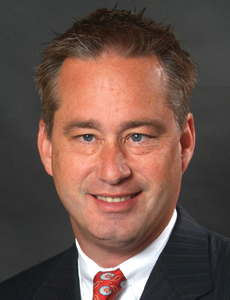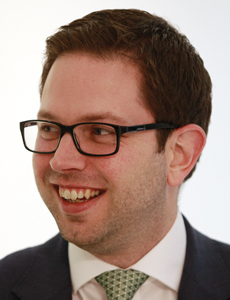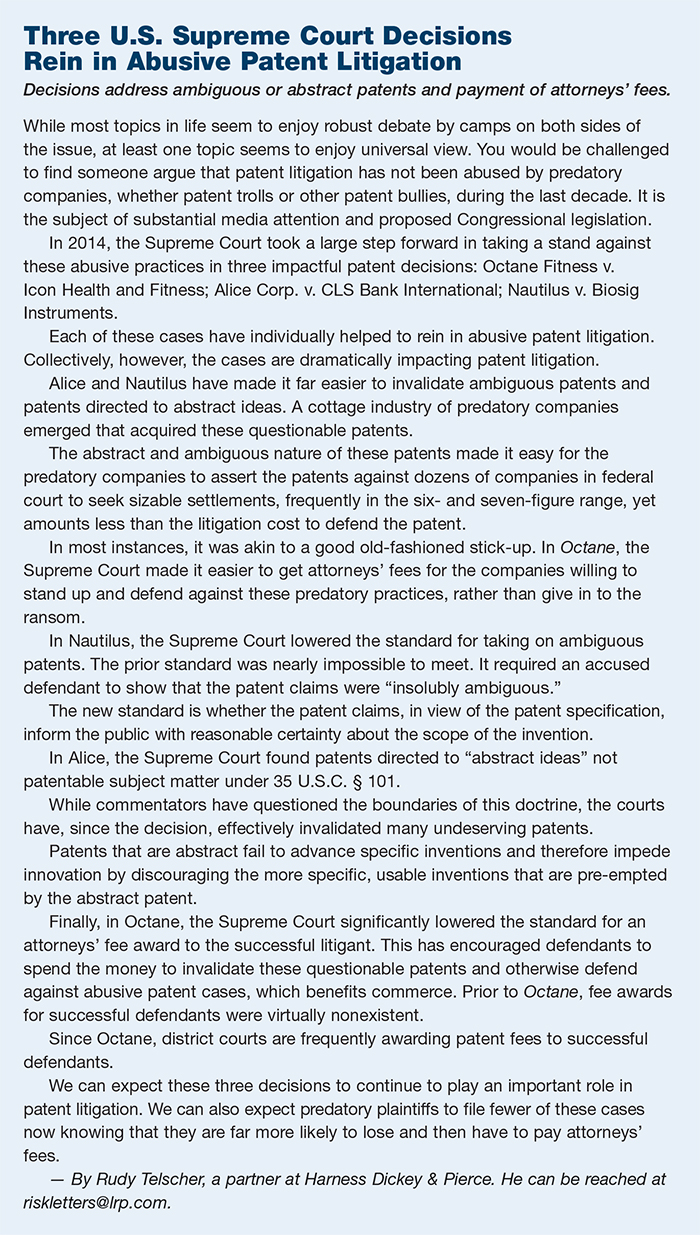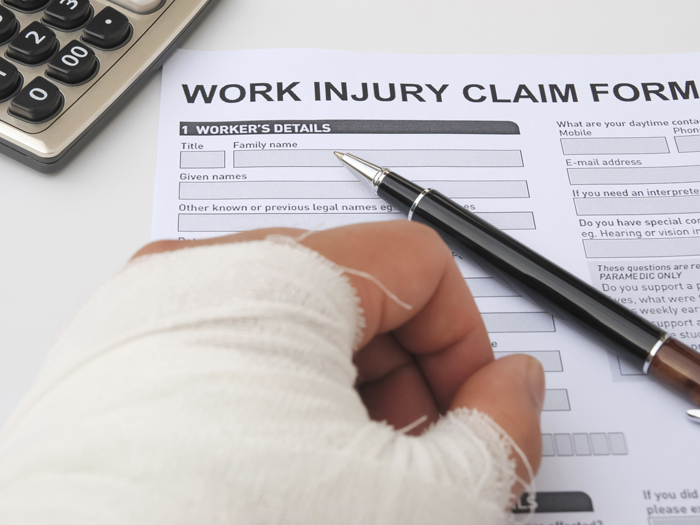Intellectual Property Risks
Taking Down Trolls
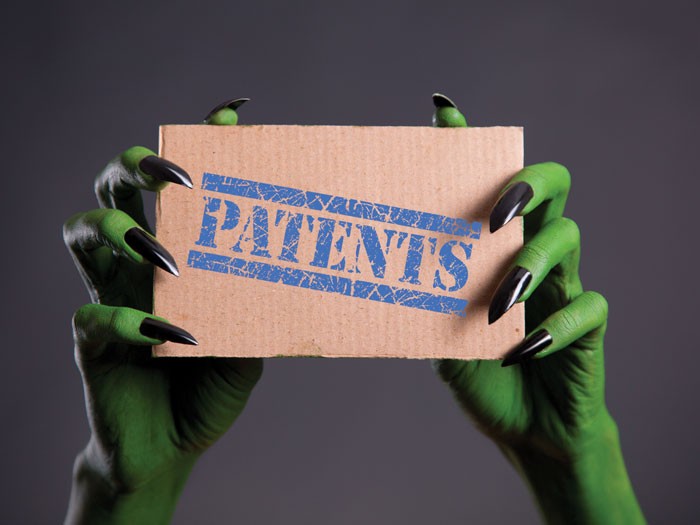
Patent trolls are a thorn in the side of many companies.
Even when infringement claims are weak, many firms opt to settle just to avoid having to spend millions defending them in court, experts said.
To be sure, the terms “patent troll” or “non-practicing entity” (NPE) are often used to paint with too broad of a brush, as some NPEs have legitimate reasons to sue for patent infringement, said Rudy Telscher, a partner at Harness Dickey & Pierce law firm in St. Louis.
Many individuals, smaller companies and universities that innovate don’t have an interest or resources to bring products to the market, Telscher said. Alternatively, they may have tried to make a go out of commercializing their patent, but found the competition too stiff. These entities determined that they would be better off having other companies pay them a royalty to use their invention or patented technology in their own products, and if others refuse to pay but still use their patent, then the NPEs rightfully sue.
An example of true patent troll abuse stems from when firms bought broadly worded patents that were issued by the U.S. Patent Office during the dot.com bubble of the late 1990s and early 2000s.
Those patents were analyzed by the government under less strict standards than those used today, Telscher said.
Patent trolls typically sue 20 or more companies to lower their own filing costs, then settle with individual defendants.
“Patent troll companies invest significant time and money to pan for gold, by trying to find these old, broadly worded patents and then assert them against industries to get royalties not reasonably owed by using the high cost of patent litigation as a coercive weapon,” he said.
Fortunately, the Supreme Court’s 2014 Octane decision made it easier for defendants to get their court fees paid by trolls if they choose to defend patent cases, Telscher said.
Moreover, the Supreme Court’s 2014 Alice decision has been used by district courts to strike down software and other patents having claims drawn to “abstract ideas,” and its 2014 Nautilus decision has been used to strike down patent claims that are vague and indefinite regarding claim scope coverage.
“While the Supreme Court cases of the last year have deterred some patent trolls from asserting the weakest of patent cases, many entities are still filing such cases,” Telscher said.
“In no case do we give NPEs any money, since we believe paying NPEs only ‘feeds the beast,’ ” — Shawn Ambwani, chief operating officer, Unified Patents
The 2011 Leahy–Smith American Invents Act (AIA), which determined how many defendants could be sued in a single case, has also had some impact on patent infringement litigation — but not as much as defendants in such cases would have liked, said Brian Howard, a legal data scientist at Lex Machina, a Menlo Park, Calif., firm that tracks district court litigation.
Insignificant Decrease in Claims
Since the new rules generally caused plaintiffs to sue defendants in separate cases rather than in a single combined case, Lex Machina counted the combinations of defendants and cases after the AIA became effective (a lawsuit by one plaintiff against three defendants is now counted as three cases for the purposes of tracking).
The company found that the new rules did not drastically reduce patent case filings. The statistics from late 2011 to mid-2013 followed a trajectory consistent with that of 2009 to early 2011. Overall, 2014 saw a steady increase in case filings through April, followed by sharp drop in May and a flat remainder of the year, leaving total filings down 21 percent from 2013.
That was “not the dramatic reduction that many were expecting,” Howard said.
Intellectual Property Insurance Services Corp., based in Louisville, Ken., offers a patent troll defense policy, said President Bob Fletcher.
If a policyholder is sued by a patent troll, the insured can solicit counsel of their choice to determine whether they would have a 51 percent chance of winning “by a preponderance of evidence,” in which case the policy would then pay for the defense. The policy covers “non-core activities” because that is the focus of many of the “bad” broadly worded patent lawsuits.
“Let’s say a firm has an Internet connection, a computer and they email something — a patent troll would sue for infringement,” he said. “For that kind of case we would not pay a settlement but would fight it to the end, because those patents never should have been granted and we would likely win. We want to teach trolls that when a client has insurance they will not settle, which will destroy the trolls’ livelihoods.”
London-based CFC Underwriting offers a variety of insurance products based on infringements of any type of intellectual property, including patents, said Erik Alsegard, intellectual property practice leader. The policies cover lawsuits regardless of whether it is a non-practicing entity or a competitive company that is suing the insured.
Before insuring, CFC reviews how companies operate, their patent risks, whether they work with a patent attorney and, where suitable, whether they run “freedom to operate” searches to mitigate the risk of patent infringement and intellectual property claims, Alsegard said.
“However, risk management and IP searches can’t 100 percent prevent claims, so that’s why insurance is really important,” he said. “The lawmakers and the courts are trying to change the behavior of patent trolls, but it is unlikely to entirely remove this risk to operating companies as the more sophisticated entities will adapt.”
Often companies will ask their suppliers to indemnify them on patent infringement lawsuits based on the product they supply, but the ability to transfer such indemnity to a supplier will depend on the strength of each party in the negotiation.
“Smaller companies are less likely to be able to negotiate away risk through contracts,” Alsegard said. “On the other hand, if a company does have to indemnify its customers, then this contractual indemnity can be insured so in a sense the insurance works as a business enabler.”
Mary Castiglia, a senior vice president at Hub International Ltd. in San Francisco, said that in the past she had been unsuccessful getting her clients to consider coverage because it had been a “fairly cumbersome underwriting process.” But now there are more options in the marketplace and firms have eased both the underwriting and claims processes. Castiglia typically works with RPX Insurance Services in San Francisco, which offers a holistic insurance and claims-settling service solution.
“We’re starting to see more interest in the marketplace to offer this type of insurance because more people are getting hit with letters from trolls,” she said.
Unified Patents in Los Altos, Calif., protects technology companies from NPE assertions using various tools, challenging patents they consider invalid using the AIA’s new “inter partes review” process, said Shawn Ambwani, chief operating officer. Since starting the challenges in 2012, United has invalidated two patents and has settled two others in which the NPEs agreed to not sue Unified’s members.
“In no case do we give NPEs any money, since we believe paying NPEs only ‘feeds the beast,’ ” Ambwani said.
Problems for Startups
Lori Johnson, a shareholder and intellectual property lawyer in the Atlanta office of law firm Chamberlain Hrdlicka, works with several large companies that budget for patent infringement claims by trolls and other entities rather than buy insurance.
However, startups should consider buying insurance, because many troll suits target the software within their websites.
“The asserted patents may have little to do with the underlying business the startup is engaged in,” Johnson said.
“It’s very easy to name call and put everyone in the same category,” he said. “But we say, hold on a second! Let’s not throw away 225 years of patenting innovations that have built value in the economy.” — Phil Hartstein, president and chief executive officer, Finjan Holdings Inc.
Startups should also consider requesting indemnification from their web development company, she said. If the development company is using off-the-shelf software, they may feel comfortable providing indemnity, but if they’re using cutting-edge software, “it’s a red flag if they do not even want to talk indemnification.”
“Most firms don’t want to indemnify if they can help it, but if they’re not even willing to talk about it, that would make me nervous,” Johnson said. “I would recommend shopping for another web developer that might be more willing to indemnify or more capable of handling a suit.”
One NPE that is fighting against the patent troll stigma is Finjan Holdings Inc. in East Palo Alto, Calif., said Phil Hartstein, president and chief executive officer. Finjan was formed in 1997 first as a software company and then as a hardware company, raising $65 million in capital over a number of rounds between 1998 and 2006 to develop content inspection technologies.
In 2005, the company struck its first licensing deal with Microsoft, without having to litigate, Hartstein said. Finjan ultimately divested the technology company. Today, it’s a publicly traded entity that seeks first to make licensing deals with companies using its patents before litigating. Major funds and companies have invested in Finjan, including Cisco Systems Inc.
“It’s very easy to name call and put everyone in the same category,” he said. “But we say, hold on a second! Let’s not throw away 225 years of patenting innovations that have built value in the economy. Let’s focus instead on giving those that exhibit positive, ethical behaviors the freedom to continue down this road.”
Finjan has posted four core values and seven best practices based on such behaviors on its website, and is working with the American Intellectual Property Law Association and the Licensing Executives Society to build certification programs for licensing entities. The American National Standards Institute has agreed to be the governing body for the “LES Standards Pilot Program.”
“If there is an opportunity for us to participate in establishing credibility in the licensing industry by disseminating best practices, that enables us to move out of the shadows of litigation arbitrage and back into the credible exchange of ideas for invested capital,” Hartstein said.

